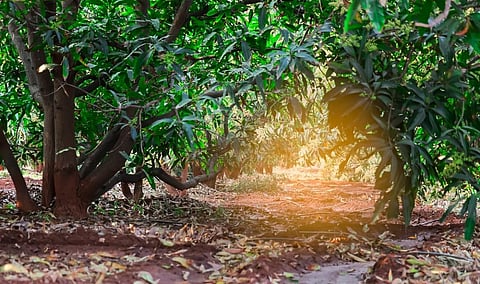

India’s State of Forest Report 2021 released January 13, 2022 shows that there is a rising trend in India’s growing stock, along with a rise in forest and tree cover by 2,261 square kilometres (sq km). Most of this spike has been due to an increase in area under Trees Outside Forests (TOFs).
Growing stock provides information on existing wood resources and is also a basis for estimating the amount of carbon contained in a forest.
The report is a biennial publication. This is the 17th such report since its inception in 1987.
The total growing stock in India has risen by 6.92 per cent to 6,167.50 million cubic metres (mcum) in the current assessment, from 5,768.387 mcum in the 2015 assessment.
The growing stock at the national level has been estimated at 56.60 cubic metre per hectare (cum per ha). The highest per ha growing stock of forest is 139.32 per ha in Kerala. Uttarakhand with 105.53 per ha and Goa with 101.26 per ha growing stock ranked second and third in the country.
Arunachal Pradesh ranks highest in terms of the total volume of growing stock at 418.99 mcum, followed by Uttarakhand with 401.01 mcum, Chhattisgarh has 389.64 mcum while Madhya Pradesh ranks fourth in the country with 374.44 mcum.
The highest per ha growing stock of forest among Union territories is in Ladakh, followed by Jammu and Kashmir and Andaman and Nicobar Islands, according to the report.
Are under TOF has shown an increase of 13.09 per cent from 2015, while the growing stock inside forests has risen by just 4.60 per cent in these years.
The report reads:
In the TOF, the growing stock has risen by 13.09 per cent to 1,779.35 mcum in the current assessment, from 1,573.340 mcum in the 2015 assessment. The growing stock inside forests has risen by 4.60 per cent, to 4,388.15 mcum in the current assessment, from 4,195.047 mcum in the 2015 assessment.
Maharashtra has the maximum growing stock of TOFs at 187.69 mcum. Karnataka has 121.72 mcum, Madhya Pradesh 118.05 mcum and Chhattisgarh 117.30 mcum.
Sal tree (Shorea robusta) contributes about 10.87 per cent to the growing stock with a volume a 476.94 mcum, followed by Teak (Tectona grandis) with 191.890 m cum (4.37 per cent).
Chir pine (Pinus roxburghii) and Silvergrey wood (Terminalia tomentosa) contribute to about 4.12 and 3.88 per cent of the growing stock.
Among the TOFs, mango trees (Mangifera indica) contribute to 12.94 per cent of the total volume, followed by neem (Azadirachta indica) with 6.78 per cent, mahua (Madhuca latifolia) with 4.65 per cent and coconut (Cocos nucifera) with 4.51 per cent, the report said.
Trees outside forests are a major source of forest produce such as timber, firewood and small wood supply. However, experts feel that scientific management of forests can also contribute to the growing demand of timber in the country.
TOFs are one of the important renewable resources that contribute to climate change mitigation, as every patch of forest around the world absorbs carbon, the report said.
Promode Kant, a retired Indian Forest Service official told Down To Earth: “Forest is a living entity. Their area has increased in the country and the number of TOFs have also shown a rise. While we depend of TOFs for timer, old and dying trees must be removed from the forests, so that they can make space for new trees that do not get proper sunlight.”
Old trees attracted more insects and diseases and also made forests prone to fire. “If these trees are harvested, the growing stock will rise even more rapidly,” he said after reading the report.
India contributes to about two per cent of the world’s forests with an area of 72.16 million ha, according to the Global Forest Resource Assessment report released in 2020.
Forests make up about 24.3 per cent of the country’s total area. India aims to have 33 per cent of its geographical area under forests in the future.